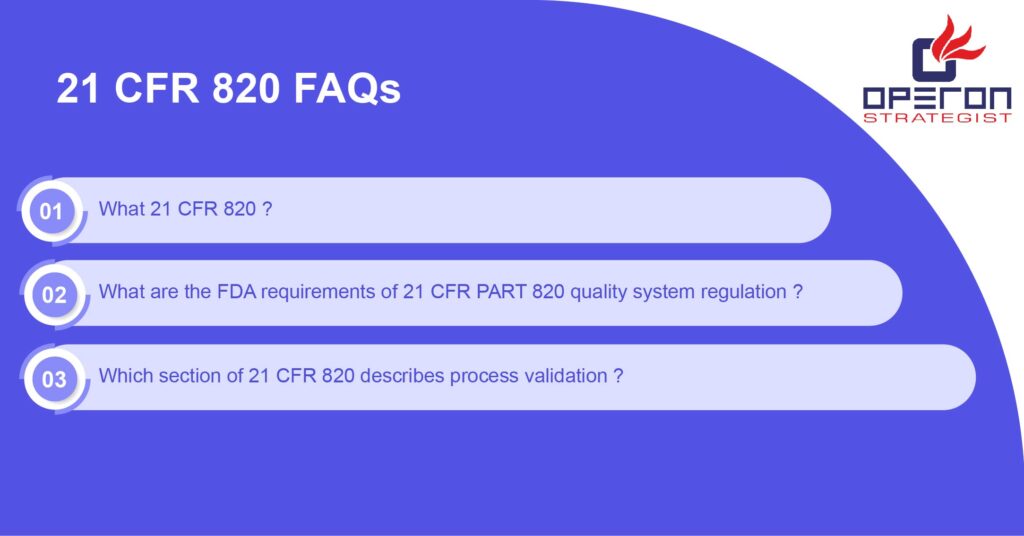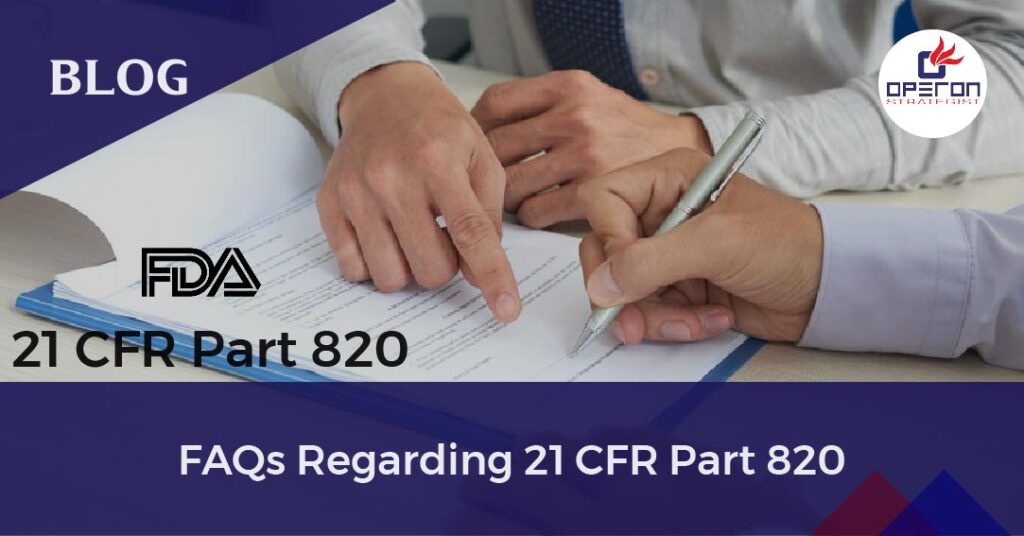21 CFR Part 820 ensures your device’s safety and effectiveness. The goal of regulatory affairs is to guarantee that your organization complies with all applicable laws and regulations. These laws, such as Quality System Regulation 21 CFR Part 820, are designed to ensure that products entering the market are safe and effective. These are some very significant 21 CFR 820 FAQs that will answer all of your questions about it.
Important 21 CFR 820 FAQs:
What is 21 CFR 820?
We have knowledge of each component and the GMP requirements that govern their development and production: Drug Devices (FDA 21 CFR Part 820) and Combination Products (21 CFR Part 4).
Looking For a Medical Device Regulatory Consultant?
Let’s have a word about your next project

What Are the FDA Requirements of 21 CFR Part 820—Quality System Regulation?
21 CFR Part 820: Quality System Requirements
The FDA performs regular inspections to ensure compliance with the QSR. The FDA employs the Quality System Inspection Technique (QSIT) to assess the compliance of internal quality system processes with regulatory requirements. The stakes in compliance are clear. Violations can lead to 483 observations and warning letters.
It addresses management responsibilities, internal quality checks, and staff. This comprises a variety of roles, as well as the responsibilities and training required for each role. encompasses managerial responsibility, which includes requirements for policies, resources, and planning:
Quality policy: Commit to quality, and guarantee that the firm understands, executes, and maintains it.
Organization: Use an organizational structure that is appropriate for the manufacturing of compliant medical devices, including delegating appropriate responsibilities to appropriate persons and providing the resources required to meet FDA regulations.
Management review: Review the QMS regularly and document such reviews.
Quality planning: Plan out the practices, resources, and activities that support quality.
Quality system procedures: Set quality system procedures and instructions.
21 CFR PART 820: DOCUMENT CONTROLS
It covers document controls. Document control refers to the rules and methods that quality managers employ to manage documents throughout the medical device product lifecycle.
General: Implement procedures to ensure that papers conform with 21 CFR Part 820.
Document approval and distribution: Designate one or more personnel to evaluate and approve papers to ensure compliance.
Document alterations: Review document modifications in the same way that you approve and disseminate them.
Which Section of 21 CFR 820 Describes Process Validation?
Section 820.75 of 21 CFR 820 discusses Process Validation.Where the results of a process cannot be fully verified through future inspection and testing, the method must be validated with a high level of certainty and approved by established protocols. The validation actions and results, including the date and signature of the individual(s) who approved the validation and, where applicable, the major equipment validated, must be documented.
21 CFR Part 820, Subpart C—Design controls.
It covers design controls. Design controls are methods that guarantee gadgets are built to their specifications.
21 CFR Part 820 of Design Controls specifies additional standards for the design process:
Design and Development Planning: I have evaluated design and development plans on a regular basis.
Design input: Ensure that design requirements are appropriate for the intended use of the device, including a method for manufacturers to address “incomplete, ambiguous, or conflicting requirements.”
Design review: Plan and carry out regular design reviews with people involved in the examined function, non-involved individuals, and specialists.
Design verification: Ensure that design outputs match design inputs.
Design validation: Ensure that equipment, including software, meets the defined user needs and planned purposes. This could include testing production units.
Design transfer: Convert your gadget to production standards.
Review design changes before implementing them.
Create a design history file (DHF) with documents demonstrating that you designed a compliant device according to your plans.
The FDA’s restrictions apply to complete device makers distributing commercial medical devices. 21 CFR 820.3(l) defines a finished device as “any device or accessory to any device that is suitable for use or capable of functioning, whether or not packaged, labeled, or sterilized.”
Navigating FDA 21 CFR Part 820 with Operon Strategist:
Operon Strategist excels in FDA 21 CFR Part 820 design controls, optimizing processes for medical devices and combination products. Understanding the distinctions between FDA 21 CFR Part 820 and ISO 13485, we merge regulatory compliance and global quality standards to elevate product development and manufacturing practices. For more information Contact us.
- adminhttps://operonstrategist.com/author/admin-2/
- adminhttps://operonstrategist.com/author/admin-2/
- adminhttps://operonstrategist.com/author/admin-2/
- adminhttps://operonstrategist.com/author/admin-2/



